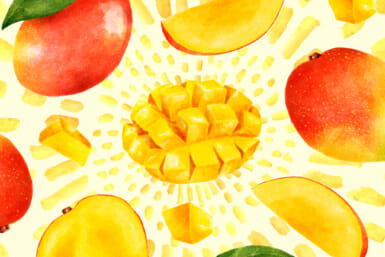with Elizabeth Andoh
There is a very special and wonderful appliance used in Japanese cooking for crushing, blending, grinding and mixing.
Called a suribachi it is a mortar and pestle type of arrangement. The bowl (mortar) is serrated and traditionally made of pottery, though the modern versions are often of plastic. The stick (pestle) is always of wood.
Available in several sizes in the housewares section (katei yohin) of department stores, the prices range from ¥500-1,500 for the suribachi and from ¥160-250 for the bo (sticks).
Some suribachi come with plastic or rubber grips on base to prevent the bowl from moving around. A towel or cloth layed between suribachi and counter will do quite well, too.
The friendliest arrangement is to have someone else hold the bowl while you grind. Once you get the idea its quite simple to whip up— or rather grind up—a tasty dressing or sauce in a few minutes.
Although the suribachi can be used for preparing many kinds of foods, sesame seed dressings (for vegetable salads and side dishes) are tasty and nourishing and will provide good practice in the art of suribachi-ing. The basic procedure is described and illustrated here:
- Dry roast sesame seeds and transfer them, still warm, to the suribachi.
- Hold the stick with both hands (either right or left hand on top is fine); the top hand presses down while the bottom hand rotates the stick clockwise against the serrated sides of the suribachi.
- Grind sesame seeds until they have all been cracked open. Add dry ingredients, such as sugar or salt, and grind a bit more. Add liquid ingredients, such as shoyu or vinegar and mix all by a few more grinding motions.
- Never use a rubber spatula to scrape the suribachi (the edges will shred and crumble against the rough serrated surface).
- For cleaning, fill the suribachi with warm sudsy water and let it soak for a while. Rinse well and turn upside down to dry. If you must scrub, then scrub WITH the grain, not against.
Special Note: A suribachi is great for creaming butter or shortening with sugar (a very Western use); softened butter should be “churned” against the serrated sides, adding a bit of sugar at a time.
KOMATSU NO GOMA AE (leafy greens in sesame dressing-a side dish)
ingredients:
- 1 bunch komatsu (or shungiku)
- 3 tablespoons white sesame seed (unroast-ed)
- 2 1/2 tablespoons shoyu
- 2 tablespoons ungranulated sugar
instructions:
1. Wash and rinse komatsu (or shungiku). Trim roots 1-2 inches. Put cleaned greens in a pot of rapidly boiling salted water. Bring back to a boil and cook 2-3 minutes (do not overcook !).
2. Douse the cooked greens in cold water to stop the cooking process. Drain and squeeze out all excess moisture.
3. Cut in 2-3 inch lengths. Squeeze out excess moisture again.
4. Prepare dressing: Dry roast the sesame seeds in a pre-heated metal pan, careful not to burn them. Crush the seeds in a suribachi. Add sugar and continue to grind until blended. Add the shoyu and mix well.
5. Toss cooked and cooled komatsu (or shungiku) in the dressing just before eating. Put a small mound in individual dishes. Serve at room temperature.
notes:
1. komatsu — a type of leafy green resembling collard greens. The roots are white (not pink like spinach) and leaves broad and flat.
2. shungiku — dandelion greens. A very flavorful vegetable available in the fall and winter. Discard any flowering buds, as these will be bitter.
* * *
INGEN NO KURO GOMA AE (string beans in black sesame dressing—a salad)
ingredients:
- 1 bunch fresh green string beans (approx. 200 grams)
- 1-2 teaspoons kuro goma
- 1 teaspoon ungranulated sugar
- 1 tablespoon shoyu
- 2 tablespoons vinegar
instructions:
1. Break off tips of string-beans and “string” if necessary.
2. Boil in rapidly boiling salted water for a few minutes. The color shoud be bright green ami the texture slightly crisp. Drain, cool, and pat dry.
3. Prepare the dressing in a suribachi (dry roast sesame and crush, adding sugar, shoyu and vinegar in order) and dress the stringbeans just before serving (prolonged contact with the vinegar will cause the color to change). Serve at room temperature or chill for a few minutes.
notes:
1. stringheans are called ingen in Japanese and tasty, fresh ones are on the market thru the early fall.
2. kuro goma is black sesame seed.
* * *
KYURI TO HAMU NO GOMA AE (cucumber and ham salad in sesame dressing)
ingredients:
- 2 cucumbers
- 2 slices of ham
- 1 1/2 teaspoon white sesame seed
- 1/4 teaspoon ungranulated sugar
- 1 teaspoon shoyu
- 1 teaspoon vinegar
- a drop of goma abura
instructions:
1. Slice the cucumbers diagonally. then in slivers. Slice the ham in slivers of approximately the same size.
2. Prepare the dressing: Dry roast sesame and crush in a suribachi adding the sugar, shoyu, vinegar and goma abura in order.
3. Toss the cucumbers and ham in the dressing right before serving (previously tossed and let to stand, the salad loses its crispness). Serve at room temperature or chill for a few minutes.
FORGOTTEN FLAVORS …the explanation for konazansho (one of the nicer spices around) was accidentally cut from the column on August 23. Gomen-nasai! Konazansho is powdered pepper-plant (sansho); more aromatic than ordinary kosho (black pepper). A small bottle will cost about ¥135. Keep the cap on tightly when not using and it should last for years.








